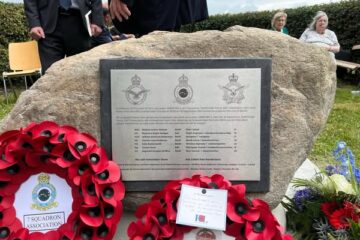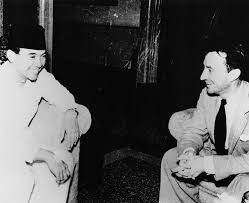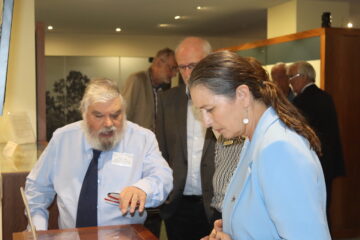Early in Roger Bell’s book Unequal Allies,he states:

”Relations between the governments of Australia and the United States underwent fundamental changes during 1941-46…Indeed it was not characterized by general bilateral accord on political, defence and economic matters during war time.”
These comments can be equally applied to the Dutch/Australian wartime relationship. Allies in a Bind charts the steady decline in this relationship. It sets the scene for the animosity that occurred because of the Australian Government lending support to the Indonesian Republic’s 1945-49 struggle for independence from the Dutch. The scale of Australia’s involvement with the NEI can be appreciated by the loss of its vital air, naval and land units for ABDA in 1942; that a NEI Government-in-Exile was the only foreign government ever established on Australian soil; and in the Dutch having larger forces than the British engaged in Australia’s defence.
The book commences with a look at the Dutch/Australian co-operation from the fall of the Netherlands in May 1940 through to the capitulation of Java in March 1942. Australia’s embroilment in the defence of the NEI resulted in Japanese raids against the Australian mainland at Darwin, Broome and Wyndham plus the loss of nearly as many Australian personnel as had surrendered at Singapore. This caused Australian bitterness and a low opinion of Dutch military competence. The Dutch could respond that they had been duped into sending their forces to help defend ‘impregnable’ Singapore and then not received adequate US and British reinforcements.
The aftermath of the Allied debacle on Java saw the Dutch reorganise their surviving resources in Australia. The Curtin Government, prepared to accept any assistance to meet the expected Japanese invasion of Australia, welcomed the arrival of the Dutch. The Dutch aided Australia by supplying aircraft to the hard-pressed RAAF, merchantmen that carried reinforcements to New Guinea and warships to protect the country’s Indian Ocean coast. When the US and Britain created General MacArthur’s South-West Pacific Area, the NEI was split between two operational commands and Australia was separated from New Zealand. This caused the Dutch and Australians, as minor powers, to unite against their treatment by the major Allied powers regarding strategic planning. This was the point in mid-1942 when Dutch/Australian co-operation reached its peak.
The Dutch commitment to the SWPA was such that by August 1945, the Dutch had allotted 19 warships, four air squadrons and three army battalions to Australia. Dutch/Australian military co-operation on Timor, in the islands of the Arafura Sea, at Merauke and other parts of Dutch New Guinea, in the Indian Ocean and in the final campaigns on Borneo, are examined. That most of these actions are unknown, illustrates how Australia has undervalued the Dutch military contribution to the Pacific War.
The deterioration in Dutch/Australian relations is charted from early disagreements over the transfer of Dutch cargoes held in Australian ports; and the Dutch push to gain access to the financial resources held by Australian banks on behalf of Dutch/NEI citizens and companies. By 1945, there was almost a total breakdown of relations. Australia dallied over relief supplies for the liberated parts of the NEI. It reneged on an agreement to allow a new Dutch army, being raised in Holland, to be based in Australia. The major disagreement centered on Australia’s postwar designs on the NEI. Australian aims alternated from increased trade and joint defence bases in the NEI to gaining a United Nations mandate over the eastern Indies. While the External Affairs Minister ‘Doc’ Evatt and his department originated these plans, the Dutch believed that it was an Australian Government policy. Dutch internal bickering weakened their position with Australia. The crux of this bickering was the distrust that the Dutch in Europe had for the political aspirations of the Dutch who came from NEI. Even the NEI Dutch who re-established in Australia were rent by the dissension between their civil administration and their military forces. It was Australia’s intention to ingratiate itself with the Dutch to gain influence over the postwar NEI. That Dutch/Australian relations had become so poisonous by War’s end shows the failure of this, one of Australia’s first efforts at conducting an independent foreign policy in Asia.
This is the second edition of Allies in a Bind, first published in 1996 as a limited edition by the Netherlands Ex-Servicemen and Women’s Association’s (NESWA) Queensland branch. This edition contains new information plus corrections of my 1995 PhD thesis and subsequent book. The NEI Order of Battle detailed in the appendices is my assessment drawn from a variety of conflicting sources.
ALLIES IN A BIND – Australia and the Netherlands East Indies in the Second World War
Dr. Jonathan (Jack) M. Ford
Revised (non published) Edition 2022. This book is now out of print. There are 2nd hand copies online

Overview of Jack’s publications
“The First Japanese Air Raid on Broome” in Sabretache, the Journal of the Military Historical Society of Australia, XXVI, 3 (July/September 1985), pp.14-18.
“The Dutch Navy in the South-West Pacific Area March 1942 to August 1945” in The Navy, the Journal of the Navy League of Australia, Vol. 47, No. 4 (October 1985), pp.31-37.
Military Museums of the Pacific Ltd re consultant historian’s report, History of Camp Columbia, Wacol. 1985.
The Dutch Wartime Presence in Australia. invited guest speaker to Nundah & Districts Historical Society, 5. November 1985.
The OPM & Irian Jaya to University of Queensland History Department, seminar presentation, 21 November 1985.
Game Research/Design company (USA), consultant historian’s report on “ Allied Order of Battle for the World War II Netherlands East Indies Campaign” for the company’s boardgame Banzai Blitzkrieg, 1985.
The Dutch Connection program on A.B.C. Radio: 1 October 1988 – We saw what war was about – Nasi Goreng for everybody, interview; 8 October 1988.
Australia and the Netherlands East Indies 1942-1945, Australian War Memorial’s “History Conference”, Work-in-Progress Session, Canberra, July 1990.
“Duping the Dutch” in World Review, Vol. 30, No. 2 (June 1991), pp.4-38.
Left in the Lurch: The A.B.D.A. Defence of the Netherlands East Indies 1941-42, Australian War Memorial’s “50th Anniversary History Conference”, Canberra, November 1991.
The Forlorn Ally – the Dutch Experience in 1942, Australian Historical Association conference, Canberra, September 1992.
“The Forlorn Ally” in War and Society, Vol. 11, No. 1 (May 1993), pp.105-128.
With Friends Like These – Australia and the Netherlands East Indies 1944-45, Queensland Studies Centre’s “War’s End” conference, Townsville, July 1995.
Camp Columbia Memorial at the Dutch Club, Durack, unveiled 10 December 1995 (text for).
Allies in a Bind (Loganholme: Netherlands Ex-Servicemen &Women’s .Association (Qld Branch), 1996 book & reprinted by N.E.S.W.A. in 1997. (Research is ongoing with a second edition planned)
The Dutch in Australia during World War II guest speaker at civic reception for Lieutenant-General A.P.M. van Baal, Inspector-General of the Royal Netherlands Armed Forces at 80b George Street, Brisbane, 16 February 2005.
“Banten Bay”, “Madoera Strait”, “New Guinea Campaign” & “Papua Campaign” entries in Encyclopedia of World War II: A Political, Social and Military History, [ed. Dr. Spencer Tucker], (Santa Barbara: ABC-CLIO, 2004).
Dutch & Netherlands East Indies WW II War Memorial, unveiled in George Street, Brisbane City on 4 May 2004 (text for), [relocated to Roma St. Parklands in 2016].
The Floating Dutchmen: the Dutch Merchant Marine in the Papua Campaign. Brisbane History Group’s “LEST WE FORGET 1942” Milne Bay – Buna- Gona – Sanananda”, 10 September 2022.



